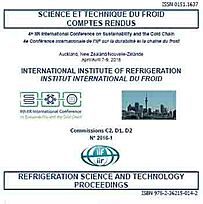
IIR document
Improving the energy efficiency and milk quality with CO2 refrigeration systems with heat recovery on New Zealand dairy farms.
Author(s) : VISSER K.
Summary
At the average New Zealand dairy farm about 6,131 litres of milk is produced daily on average from 420 cows over a 300 day period. The cows are dry for about 8-10 weeks during May to July. The warm milk from the cow is pumped into a tank with a part refrigerated wall and slowly cooled with an agitator providing movement of the milk past the cooled tank wall.
It is proposed that a small CO2 system with heat recovery produces chilled and hot water at low off peak electricity rates. Chilled water equal to 1.5 times the daily milk production is stored, as is hot water for daily CIP and general cleaning.
During milking the milk is cooled very quickly to a temperature not exceeding 7°C before it enters the storage tank. Below 7°C salmonella and E-coli do not grow. In addition to enhanced food safety, other benefits of the proposed CO2 refrigeration technology are improved product quality, reduced energy consumption and costs, and reduced direct and indirect Global Warming Emissions.
Available documents
Format PDF
Pages: 8
Available
Public price
20 €
Member price*
Free
* Best rate depending on membership category (see the detailed benefits of individual and corporate memberships).
Details
- Original title: Improving the energy efficiency and milk quality with CO2 refrigeration systems with heat recovery on New Zealand dairy farms.
- Record ID : 30017526
- Languages: English
- Source: 4th IIR International Conference on Sustainability and the Cold Chain. Proceedings: Auckland, New Zealand, April 7-9, 2016.
- Publication date: 2016/04/07
- DOI: http://dx.doi.org/10.18462/iir.iccc.2016.0029
Links
See other articles from the proceedings (63)
See the conference proceedings
Indexing
-
Energy efficient dairy shed milk cooler and wat...
- Author(s) : REKSTAD H., HAFNER A., JENSSEN S.
- Date : 2012/06/25
- Languages : English
- Source: 10th IIR-Gustav Lorentzen Conference on Natural Working Fluids (GL2012). Proceedings. Delft, The Netherlands, June 25-27, 2012.
- Formats : PDF
View record
-
Computational model of a PCM heat exchanger for...
- Author(s) : PARK J. Y., FARID M.
- Date : 2016/04/07
- Languages : English
- Source: 4th IIR International Conference on Sustainability and the Cold Chain. Proceedings: Auckland, New Zealand, April 7-9, 2016.
- Formats : PDF
View record
-
Sustainability within food cold chain sectors i...
- Author(s) : WIDELL K. N., VINGELSGARD E., DALSVÅG H., MEHTA S., NORDTVEDT T. S.
- Date : 2023/08/21
- Languages : English
- Source: Proceedings of the 26th IIR International Congress of Refrigeration: Paris , France, August 21-25, 2023.
- Formats : PDF
View record
-
HFC134a in farm vat dimple pads.
- Author(s) : KEEDWELL R. W., BALDWIN A. J.
- Date : 1993/11/15
- Languages : English
- Source: Cold Chain Refrigeration Equipment by Design.
- Formats : PDF
View record
-
Evaluación de estrategias para minimizar las em...
- Author(s) : COCA-ORTEGON A., PRIETO J., FELIPE X., et al.
- Date : 2016/05/03
- Languages : Spanish
- Source: CYTEF 2016. VIII Congreso Ibérico y VI Congreso Iberoamericano de las Ciencias y Técnicas del Frío, Coimbra-Portugal, 3-6 mayo, 2016.
- Formats : PDF
View record
